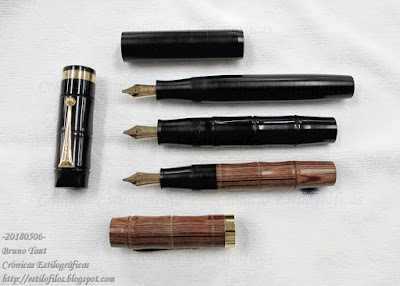Pen shows are always exciting events for the aficionado. They are also overwhelming and intimidating, but that is part of the appeal, for in a pen show, more is always more--and better.
Then, immersed in that abundance of pens –and with limited resources in the pocket—the aficionado faces a fundamental question:
‘How do I proceed?’
 How do I proceed? (Madrid Pen Show 2012).
How do I proceed? (Madrid Pen Show 2012).
Some years ago I wrote
a short list of tips on how to face a pen show. Then, members of the Spanish pen community through the forum
“Foro de Estilográficas” (excuse the overwhelming adds, but it is hosted on a free server) added their insights and comments. This is what came out:
I. BEFORE THE PEN SHOW.
1. Keep focus on what you want. This might be a model, a brand, a category of some sort, etc. Your eyes and your brain will quickly filter the signal from the noise.
However, do not close your eyes totally to those pens not fitting your primary interest. A pen show is an exceptional opportunity to see and to touch extraordinary pens.
2. Do your homework—learn as much as possible about the pens you are specifically interested, check prices,… All that will help you to analyze the pens and to negotiate their prices.
 Madrid Pen Show 2015.
Madrid Pen Show 2015.
II. TIMING.
3. Try to get a general view of the event before pulling the trigger. A pen show takes time and you cannot rush it. Gauge the right time to buy. On one hand, there are pens that will disappear quickly from the tables (and this is an additional reason why point 1 is important). On the other, at the last minute, vendors are keener on offering discounts.
You must understand and accept that you will not see all the pens on display. That is why point 1 is so important—at least you will see most of the pens you were interested on.
 Tokyo Pen Trade 2017.
Tokyo Pen Trade 2017.
III. BUYING.
4. Ask, touch, try… and ask again. Ask for help if you needed it. Don’t be shy and learn from vendors and fellow visitors.
5. Inspect the pen carefully. Cracked nibs and barrels, fading colors, erosions… All that will serve you to negotiate the price and to avoid later disappointments. A magnifier comes in handy.
6. Negotiate and bargain... politely. Think of buying more than one pen for a lower price. Some vendors might accept a pen you want to sell as part of the payment.
If buying, get the data of the vendor for possible follow ups on the purchase. Not all vendors have the same policy.
 Madrid Pen Show 2017.
Madrid Pen Show 2017.
May no one be afraid of a pen show. Everybody, even the more seasoned collector, is overwhelmed.
Enjoy!
Montblanc 149 – Platinum Black
Bruno Taut
Nakano, August 2nd 2018
etiquetas: evento































































